
No real justification was ever made for the US move on China
by Salman Rafi Sheikh, with New Eastern Outlook, Moscow

[Editors Note: Once again, America has made a grandly announced military shift with some very obviously missing components. No real threat was identified anywhere in the discussion.
China is the assumed target, but it has no force projection ability or an overseas based network which would be critical for any on the water assets.
All claims of a growing Chinese military threat are completely bogus. In return for maintaining military spending levels, the Joint Chiefs feel it is their duty to go along with the charade.
The buzz phrase that seems to be consistently used is… ‘our interests’. It seems that word has come down from that top that no one will ever specifically identify what they are, other than the silliness put out to fool the taxpayers. Once upon a time during the Cold War the term ‘national security interests’ was always the umbrella for all American force projection…but no more. Why? What has change?
All I can see is they don’t want to trot out a hyped up specific threat as it would then be challenged. The public and the world are very sensitive and very savvy in regards to the pretend-a-threats that thy have been conned on since 911, particularly now that it is widely known that Al Qaeda was an creative on Western, Israel, and Saudi intelligence entities.
That governments want to hide their true motives for geopolitical moves comes as no surprise. But where is our watchdog media? Where are the think tanks? Where are all the budget targets that are being cut for lack of funding? Why are none of these people raising hell over our new smoke and mirrors foreign policy?
Is it because there is no military threat at all, and that admitting that our military has now been reduced to a mercenary force for US and ‘other’ business interests, similar to the British John Company, (what the soldiers called it) of the old India days…formally known as the East India Company?
Is that why 50% of all the new West Point Officers are bailing out of their commissions after their five year commitment? That is what many parents have been admitting to me.
When Americans owned most of the wealth there was some theoretical justification, but now that it is being transferred into the hands of the few, Sheldon Adelson the billionaire is giving orders to do a ‘nuke demonstration’ to Iran because it would be good for Israel. Imagine that.
Have Americans become a people on their knees, who can’t be bothered to deal with anything past the edge of their font lawn, unless it effects their checking account directly? There will be much blame to go around, just as there has been post 911 when we learned that those knew the phony 911 commission was rigged…said nothing.
Are we really being protected from any real threats, or are the threats being created by those in the business of eliminating them as part of a never ending grand con game? It is a game that bankers and military industrialists love to play. I have great fear for the real answers to these questions… Jim W. Dean ]
____________________________________
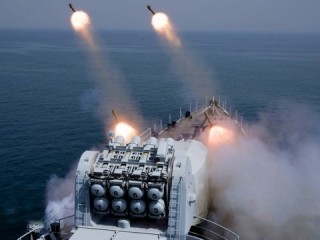
The US’ “Asia Pivot” policy, announced in June 2012, has since been heralded as a ‘new’ cold war in a new disguise against a newly emerging strategic competitor—China.
Some analysts have even gone to the extent of tracing seeds of a major armed conflict in the Far East between the US and China.
Although it is not surprising to witness such policy shifts in the world largely governed by power-politics and characterized by ‘hard’ competition among major powers, what is surprising in this particular case is the timing of the announcement of this policy.
It came at a time when the US was planning to flee from Afghanistan after a dreadful experience of more than a decade long military conflict.
Secondly, it came amid brewing economic crisis when the US economy was and still is not in any position to sustain long term military and naval presence in the Pacific Ocean.
For example, the recent cancellation of President Obama’s visit to Asia came against the backdrop of certain broad budget cuts known as the “sequester,” plus the government shutdown over a bitter spending dispute. This visit of the US President was significant in that it was part of the “Asia Pivot”, and was supposed to ‘strengthen’ ties with the US’ traditional allies in the Pacific region against China.
This has led many to question the very ability of the US to implement the rebalance to Asia and stay in power unchallenged. This observation seems weighty since the Asia pivot is supposed to put the US military in a competitive position vis-à-vis China, and if the US fails at this critical stage in deploying the required forces in the region, it would result in a major strategic defeat.
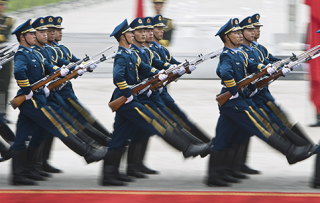
Amid this crisis, however, the US defence and foreign secretaries continue with their efforts to revamp the US’ dwindling position in the Far East, thereby signifying the crucial importance of this region for the US.
This leads us directly to the all important question: Why is it so significant for the US to operationalize the Asia Pivot specifically against China?
The most plausible answer lies in the explicitly stated objective of the “Asia Pivot” in the very title of the official policy document of the US.
In January 2012 the three officials in charge of U.S. global military strategy and operations – commander-in- chief President Barack Obama, Secretary of Defense Leon Panetta and Chairman of the Joints Chiefs of Staff General Martin Dempsey – unveiled the 2012 Defense Strategic Guidance, entitled “Sustaining U.S. Global Leadership: Priorities for 21st Century Defense,” which officially confirmed American plans to increase its military presence in the Asia-Pacific region to counter China, now the world’s second-largest economy.
And, in June 2012, in a major security policy speech at the Shangri-La Dialogue at Singapore, Defence Secretary Leon Panetta unveiled plans to shift the bulk of the US naval fleet to the Pacific by 2020 as part of a new strategic focus on Asia.
Panetta said: “By 2020, the navy will reposture its forces from today’s roughly 50/50 percent spilt between the Pacific and the Atlantic to about 60/40 split between those oceans.” The objective would be to “rapidly project military power if needed to meet”the US security commitments in the region, notwithstanding China’s own rapidly growing military might.
What has made the US weary of China is the rapidity with which the latter is building its military muscle. According to the Stockholm International Peace Research Institute (SIPRI), China’s defence expenditure rose from $30 billion in 2000 to almost $120 billion in 2010.
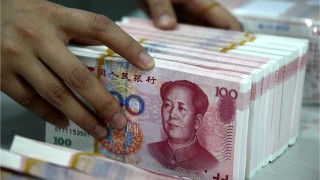
In 2012, China’s defence expenditure is expected to be $160 billion as against $750 billion in the case of the US. China’s defence spending may overtake America’s after 2035 if the present trends continue.
China, with a population of 1.3 billion, has already emerged as the second largest economy in the world in nominal dollar terms and may surpass the US economy in purchasing power parity terms within the next five years if the present trends continue.
Even in nominal dollar terms, it may overtake the US economy by 2025. Although the US still remains the most powerful nation in the world, both militarily and economically, the situation is rapidly changing due to China’s meteoric economic rise. In fact, in economic terms the world is no longer unipolar.
It has now assumed a multipolar character where decisions on important international economic issues must be taken through consultations among major economic powers as symbolized by G-20.
The US has already lost the ability to dictate to the rest of the world on international economic issues, even though it still wields considerable clout because of the size of its economy, and military prowess.
The shift in focus to Asia also came amid increasing concern at the Pentagon over China’s strategic goals, as the latter began to field a new generation of weapons that could prevent the US naval and air forces from projecting power into the Far East.
In other words, while the US wants to keep the strategic option to project its military power close to China’s shores far away from its own territory, it finds China’s plans to develop capabilities for defending its economic and security interests even in areas close to its own territory a matter of ‘grave concern.’
[Editor’s Note: This is the new military threat hustle. Anyone who can defend themselves is deemed to be threat. This is an inherent imperial and colonial attitude completely out of place in the 21rst century.
What this is really all about is using a bogus military threat behind which to conduct economic war fare, which we know now, for sure, does not have a trickle down effect. We are not at war now (they use to call these ‘police actions’) and our own commercial and political interests are ‘third worlding’ us as I type. THEY are the real threat, not China.]

That China is the primary target of the US’ policies was more than evident in the speech of Chuck Hagel to the Shangri-la Dialogue in Singapore in 2013—the region’s top annual security conference—in which he openly accused China of being involved in cyber espionage against the United States, claiming that some cyber intrusions “appear to be tied to the Chinese government and military.”
His remarks are part of a mounting campaign by Washington aimed at targeting the new Chinese leadership by subjecting it to ‘external’ pressures.
However, notwithstanding such propaganda campaigns, the two key areas of conflict between China and the US in Asia Pacific region, apart from Taiwan, can possibly be South China Sea and Strait of Malacca. The South China Sea issue is gaining momentum with many regional countries, including China laying claims to the Spratly Islands archipelago and its mineral/fossil riches.

The South China Sea issue can also become the flashpoint to initiate a war with China to stunt its rapid growth into a global rival of the US. The Malacca Straits provide the most economic Sea Lines of Communications (SLOCs).
All the countries or economies of the Asia pacific region thus have a compulsion to keep it open and navigable at all times.
And the only naval power with the wherewithal to decisively control the Malacca Straits and other SLOCs – is the US, at least in the eyes of majority of related countries, excluding China.
The blockade of the SLOCs through the Malacca Straits (and others) can be the leverage that could force China to submit to the US’ demands or hegemony.
The USA’s strategic moves, particularly in these two areas, do indicate an emerging crescent of containment around China. It ranges from Afghanistan in the west to Arunachal Pradesh on the Sino-India border in the Himalayas in the centre and onto the Pacific Ocean in the east where the US and its allies are present with their formidable militaries. But how is the US attempting to accomplish it?
Apart from the US’ decision to send its naval fleets, the US has also decided to allocate 60 percent of its overseas-based Air forces to the Asia Pacific—including tactical aircraft and bombers from the continental United States.
In addition, the US is also strengthening its alliances with Australia, Japan and South Korea to contain China.
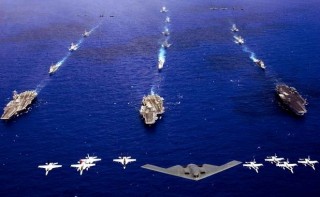
For the same purpose it is contributing to the economic and military buildup of India also.
It is also trying to take advantage of the sensitivities of member states of ASEAN, regarding the rapid growth of China’s military power and the territorial disputes in South China Sea between China and some of the ASEAN states to drum up opposition to China in the region.
Whether or not the US would be able to attain its objectives is a moot question; for, three factors are likely to hamper this American ‘enterprise.’ These are: 1) the US’ deteriorating economic situation, 2) China’s countermeasures.
The economic factor, as mentioned above has already started to affect the entire project, and Chinese reaction would further jeopardize it. 3)Growing discontentment among the people over the US’ policies of intervention. Let’s analyze these one by one.
Over the past decade, American aid in the form of military and counter-terrorism training and weaponry were poured into five countries. According to a Congressional Service Report (CRS) issued in August 2008, Indonesia led the US list of counter-terrorism aid recipients with an average of US$150 million in annual aid between 2006- 2008.
However, because of the declining economic situation, the US can no longer afford to continue its checkbook diplomacy. According to a CRS report released in July, no Southeast Asian country will be among the top ten global recipients of US aid for fiscal year 2013.
On the other hand, China’s continues to ‘invest’ heavily in the region by giving aid and soft loans, and is also keen on translating these economic relations into strategic alliances.
Secondly, China’s ‘String of Pearls Strategy’ is specifically designed to find viable alternatives to the Malacca Straits and to seek a presence in the Indian Ocean. It is also working to translate its critical interests in Pakistan (Gwadar), Sri Lanka, Maldives, Myanmar into tangible counter moves.
It also intends to launch a massive diplomatic initiative and particularly engage ASEAN, regional countries and India to forestall their joining cause with the US. Geo-economically, Pakistan is indispensable to the Chinese.
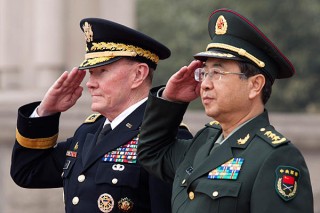
Together they can develop the North-South trade corridor linking Xinjiang province in western China to Pakistani ports on the Arabian Sea.
China’s presence in Gwadar will bring it close to Iran and the Hormuz Straits. And, geo-strategically, China is attempting to effectively counter-balance and neutralize the US’ and its allies’ leverage over Strait of Malacca by establishing itself at Gwadar and Strait of Hormuz, the latter being a strategic vulnerability for both the US and its allies.
However, it appears that China’s anti-containment policy is more defensive than offensive.
It seems that the main focus of China’s military strategy for the time being is to deter the American aircraft-carriers and air crafts from operating freely within what is known as the “first island chain”, including areas close to China’s shores in case of outbreak of hostilities.
In particular, it aims to have the capability to take military action, if ever Taiwan declares independence and to repel any external force of intervention. China is, therefore, investing heavily in asymmetric capabilities to blunt America’s still formidable capacity to project power in the region.
Over and above these factors, the growing peoples’ struggles against and resistance to the maintenance and expansion of US overseas military bases, and to US militarism, intervention and war as a vital element could impede the success of the American project.
In addition, American peoples’ impatience, as a result of Iraq and Afghanistan Wars, with the US interventions in foreign lands is likely to jeopardize many of the US government’s strategic projects.
The analysis shows that both the US and China are engaged in close military competition in the Asia pacific region. The purpose of the US’ Asia Pivot is the containment of China, establishment of its own hegemony, and sustenance of its “global leadership.”

However, the US’ economic problems are crippling its ability to project power effectively against China.
Whether or not the US would be able to ever contain China is a moot question; however, it seems clear that any armed confrontation between them would have devastating consequences for the region.
The US, given its economic conditions and popular resentment, cannot easily afford to use its economic power to ‘buy’ the allegiance of regional countries.
But it does not mean that the US would simply withdraw.
It can resort to some other options, such as the option of a limited conflict or most probably a proxy war in the region against China as in Taiwan.
By engaging China in a military conflict, and by creating conditions of controlled instability, the US can create disturbance in the region just enough to execute the “Asia Pivot.”
Salman Rafi Sheikh is a research-analyst of International Relations and Pakistan’s foreign and domestic affairs. Exclusively for the online magazine New Eastern Outlook.
Editing: Jim W. Dean
__________________________________

Jim W. Dean was an active editor on VT from 2010-2022. He was involved in operations, development, and writing, plus an active schedule of TV and radio interviews.
ATTENTION READERS
We See The World From All Sides and Want YOU To Be Fully InformedIn fact, intentional disinformation is a disgraceful scourge in media today. So to assuage any possible errant incorrect information posted herein, we strongly encourage you to seek corroboration from other non-VT sources before forming an educated opinion.
About VT - Policies & Disclosures - Comment Policy



